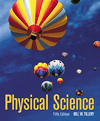|
 |  Physical Science, 5/e Bill Tillery,
Arizona State University
Electricity
Exercises- A rubber balloon has become negatively charged from being rubbed with a wool cloth, and the charge is measured as 1.00 x 10-14 C. According to this charge, the balloon contains an excess of how many electrons?Answer
- One rubber balloon with a negative charge of 3.00 x 10-14 C is suspended by a string and hangs 2.00 cm from a second rubber balloon with a negative charge of 2.00 x 10-12 C. (a) What is the direction of the force between the balloons?Answer (b) What is the magnitude of the force?Answer
- A dry cell does 7.50 J of work through chemical energy to transfer 5.00 C between the terminals of the cell. What is the electric potential between the two terminals?Answer
- An electric current through a wire is 6.00 C every 2.00 s. What is the magnitude of this current?Answer
- A 1.00 A electric current corresponds to the charge of how many electrons flowing through a wire per second?Answer
- There is a current of 4.00 A through a toaster connected to a 120.0 V circuit. What is the resistance of the toaster?Answer
- What is the current in a 60.0 Ω resistor when the potential difference across it is 120.0 V?Answer
- A lightbulb with a resistance of 10.0 Ω allows a 1.20 A current to flow when connected to a battery. (a) What is the voltage of the battery?Answer (b) What is the power of the lightbulb?Answer
- A small radio operates on 3.00 V and has a resistance of 15.0 Ω. At what rate does the radio use electric energy?Answer
- A 1,200 W hair dryer is operated on a 120 V circuit for 15 min. If electricity costs $0.10/kWhr, what was the cost of using the blow dryer?Answer
- An automobile starter rated at 2.00 hp draws how many amps from a 12.0 V battery?Answer
- An average-sized home refrigeration unit has a 1/3 hp fan motor for blowing air over the inside cooling coils, a 1/3 hp fan motor for blowing air over the outside condenser coils, and a 3.70 hp compressor motor. (a) All three motors use electric energy at what rate?Answer (b) If electricity costs $0.10/kWhr, what is the cost of running the unit per hour?Answer (c) What is the cost for running the unit 12 hours a day for a 30 day month?Answer
- A 15 ohm toaster is turned on in a circuit that already has a 0.20 hp motor, three 100 W lightbulbs, and a 600 W electric iron that are on. Will this trip a 15 A circuit breaker?Answer
- A power plant generator produces a 1,200 V, 40 A alternating current that is fed to a step-up transformer before transmission over the high lines. The transformer has a ratio of 200 to 1 wire loops. (a) What is the voltage of the transmitted power?Answer (b) What is the current?Answer
- A step-down transformer has an output of 12 V and 0.5 A when connected to a 120 V line. Assuming no losses: (a) What is the ratio of primary to secondary loops?Answer (b) What current does the transformer draw from the line?Answer (c) What is the power output of the transformer?Answer
- A step-up transformer on a 120 V line has 50 loops on the primary and 150 loops on the secondary, and draws a 5.0 A current. Assuming no losses: (a) What is the voltage from the secondary?Answer (b) What is the current from the secondary?Answer (c) What is the power output?Answer
|
|
|



 2002 McGraw-Hill Higher Education
2002 McGraw-Hill Higher Education

 2002 McGraw-Hill Higher Education
2002 McGraw-Hill Higher Education